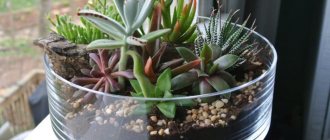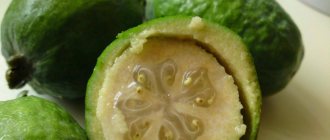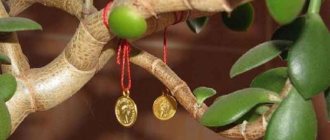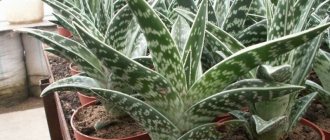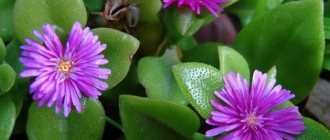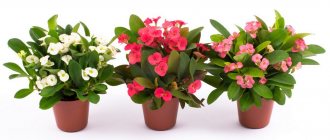What size container should be for planting aloe?
A properly selected pot for aloe will provide good conditions for plant growth. Home care in this case will consist of monitoring whether there is enough space for the plant in the pot. The calculation is simple: the length of the sheet and the diameter of the dish are equal to the ratio 2:1. The depth of the pot should be small. It is best to purchase ready-made soil, especially for succulents. The soil should not contain peat. Properly selected dishes will help ensure good care of the plant at home.
Plant transplant method
After the preparatory work has been completed, you can begin the main work. Considering the age of the plant and its size, it is advisable for the owner to know how to replant aloe at home. The procedure should be something like this:
- Take a plant and examine the rhizome. If it grows to the sides, then you need to choose a wide pot. If the rhizome grows downwards, then a deep bowl will be required.
- Pour a little earthen cushion into the prepared pot.
- Carefully take the plant and place it in a new container, adding a little soil to the sides.
After a few days the soil may become compacted and may need to be added a little bit at a time. Place the transplanted plant in the shade for about a week. Watering begins after five days. Only after this time has passed, the plant is transferred to a lighted place.
Using the flower tip
Using the top of an aloe for propagation causes injury to the plant, but it is often used to rejuvenate an aged flower and if its lower leaves and side shoots have already been cut off. This method is simple and easy to perform and leads to rapid rooting of the apical process.
It is carried out as follows:
- the top must be trimmed so that it has at least 7 leaves;
- the cut off top is dipped cut into a solution of phytohormone growth or other root growth stimulator and kept for 30 minutes;
- then the treated shoot is placed in a glass container with warm (but not hot) water;
- soon the first roots appear, and after they reach 6 cm, the rooted top is planted in the soil in a separate bowl.
The top should only be cut off with a clean, sterile instrument, since the slightest contamination can cause an infection in the flower. Some gardeners advise, after cutting the top, to keep the shoot for several days in a dark room until a protective film forms, and only then put the top in water.
Aloe propagation methods
There are several options for propagating this succulent. We choose a way to propagate aloe at home, for example:
- Radical shoots.
- Plant cuttings.
- Seeds.
- Upper shoots.
Reproduction by root shoots coincides with the planned transplantation of an adult plant. Using a sharp knife, you need to separate the shoot (it is also called “baby”) and place it in a glass of water for the roots to grow. It should take about two to four weeks for the shoot to take root. So, it's time to transplant it into a pot. Then all that remains is to follow the rules on how to grow aloe at home.
Propagation by cuttings involves using a very sharp knife to cut a leaf from an adult plant that has at least eight large leaves. The cut area should dry out a little. Treat the cut with ground activated carbon. This leaf needs to be stored outdoors for about a week. After the cutting site has completely dried, the cuttings can be planted in the ground. If there are a lot of cuttings, then they are planted in rows. Aloe cuttings can be carried out throughout the year.
Propagation by seeds is carried out in early spring, around March-April. You should first prepare small dishes and soil. The room temperature should be more than +20 °C. Water the soil in the container and spread out the seeds, cover it with a thin layer of sand, and cover the container with glass or film. It is necessary to provide watering and spray the emerging leaves in a timely manner. As soon as three true leaves appear, the seedlings need to be transplanted into other containers no more than five centimeters high. After a year, the grown plants are transplanted into larger containers. This is not the easiest method of propagation, but a large number of plants can be grown.
Reproduction by upper shoots occurs in the same way as by basal shoots. After cutting off the top with a sharp knife, the plant is dried for about three days. Then they are planted in wet sand to a depth of three to four centimeters. After rooting, they are transplanted into another container, and then they begin to grow aloe at home like any indoor plant, with love and care.
Interesting Facts
This plant is not only elegant and beautiful, it brings great benefits. In the room where the flower is located, the air is purified, it becomes much easier to breathe, and the health of the inhabitants of the house improves, troubles and sorrows recede.
Aloe is able to protect the residents of the apartment where it grows from failures, troubles and ailments. If a sick person hangs agave leaves around his neck in a bag, the disease will soon recede. The flower is believed to attract love. A girl who wants to get married quickly can speed up what she wants by performing the following ritual:
- it is necessary to carefully cut 13 leaves from the plant, after asking its forgiveness;
- the leaves are placed in a dark, dry place for 13 days;
- They burn dry leaves and scatter the ashes near the threshold of their apartment.
Having completed the ritual, there is no doubt about the speedy result.
Aloe care
Experienced gardeners share some recommendations for caring for plants:
- It is necessary to organize proper watering of aloe at home. Watering is not done often. In summer, water moderately once a week. In cool weather, watering is reduced to twice a month. To avoid water stagnation, you need to use drainage, maintain a water temperature for irrigation of at least +25 °C, and be sure to use a tray with liquid.
- Regularly (from spring to autumn) feed the plant twice a month. Fertilizer for aloe should be specifically selected for succulents or cacti.
- Regularly spray the leaves of the plant and the air around them. Dry indoor air is very harmful to aloe.
- In winter, you need to try to ensure peace for the plant. Stop feeding, do not replant and water less.
- The room should be regularly ventilated, but without drafts.
- In the fall, be sure to carry out sanitary pruning. Removing dry and diseased leaves. Those leaves that have lost their bright color also need to be removed.
- Seed the plant regularly to avoid sprouts growing haphazardly in the pot.
- From time to time you can use complex mineral fertilizers for indoor crops. Excessive, unsystematic feeding can damage aloe.
- It is necessary to regularly and carefully inspect the young plant for the presence of harmful insects. Aloe can be affected by scale insects and spider mites. When the first signs of infection are detected, the plant must be treated immediately. For example, spray with a solution of laundry soap or a weak solution of vinegar. To completely free the plant from insects, it will be necessary to carry out repeated treatment with insecticides.
- No less dangerous pests for aloe are mealybugs and thrips. It is necessary to spray the plants with the biological product “Fitosporin”.
- Protect young plants from diseases. They can get fungal diseases. Dark green spots will appear on the plant. In this case, you will have to treat the plant with an antifungal agent.
These valuable recommendations from gardeners will tell you how to care for aloe at home.
Aloe vera is a plant that does not require particularly close attention to make caring for it at home a pleasure.
Diseases and pests
Like any other plants, aloe is susceptible to various diseases and pest attacks.
The following describes the causes of certain problems with the flower, in particular why the tips of its leaves dry out. Here are some common examples.
- The tips of the leaves dry out. A clear sign that the plant is high time to replant. The root system has no place to develop, the soil is depleted and there are no more nutrients left in it.
- Root rot. The disease is provoked by excess watering and low temperatures, while plant growth is delayed and the stem dries out. For treatment, rotten roots are carefully removed, and the remaining ones are sprinkled with sulfur and charcoal. After this, the plant must be transplanted into soil with a high sand content.
- Yellowing of aloe. The problem can be caused by either excessive watering or an acute lack of moisture. In addition, soil that is too heavy or dense can cause yellowing. To eliminate the problem, the agave is transplanted into loose soil and watering recommendations are followed.
- Spider mite. The presence of this pest is indicated by the appearance of cobwebs on the leaves, a change in the color of the stem to yellow, and then to red. You need to fight the tick with the help of acaricides, supplemented with garlic tincture.
- Shield. It sucks the juices out of aloe and provokes the development of mold and mildew. For treatment, agave is sprayed with insecticidal preparations. The treatment procedure is carried out several times at weekly intervals.
There is nothing difficult about growing agave. The most important thing in the process is to provide the plant with the right place to grow, follow the watering regime and the rules for caring for aloe in winter.
The healing properties of aloe juice
Aloe juice is extremely beneficial. They treat inflammatory diseases of the skin. It copes well with a runny nose. Extracts from the plant are used in the production of cosmetic products. People have always known the beneficial properties of aloe:
- Bactericidal - in the treatment of purulent wounds, calluses, burns and other skin problems, a compress of pulp is used.
- Laxative and choleretic - treatment with aloe juice increases appetite, improves peristalsis, and restores the functioning of the pancreas.
- Anti-inflammatory - aloe juice is used in the treatment of gastritis and infectious diseases.
It must be remembered that taking aloe juice without a doctor’s recommendation is extremely unsafe. Freshly prepared juice cannot be stored.
Description of aloe vera flower
A bush with a short stem - this is what a flower looks like in nature. Its root system is poorly developed. The leaves are directed upward and have a fleshy structure, with thorns along the edges, and are able to retain moisture for a long time. The leaf width reaches approximately 15 centimeters, and the leaf length ranges from 60 to 100 centimeters. The leaf color is bright and rich. The color of the leaf can have two options: green and blue-green.
15 plant species are medicinal. Among them, aloe vera is considered especially popular.
Aloe vera has several names, namely: aloe Barbados, also known as real aloe. Barbados is the birthplace of this most valuable flower. As a houseplant, aloe vera is grown much less frequently than the tree plant.
The most valuable component is the unique aloe vera juice. No less useful is the gel-like mass that is located inside the sheet. In cosmetology, pulp and juice are widely used. Gels, scrubs, and masks are prepared from it.
The most studied succulent turned out to be aloe vera; its medicinal properties and uses have been known for a very long time and have been thoroughly studied. It is actively used in folk medicine, pharmacology, perfumery, and cosmetology. This flower is considered the most unpretentious indoor plant.
You just need to know how to grow aloe vera at home and organize proper care for the plant.
Important! You need to know that when growing a flower for medicinal purposes or cosmetic procedures, you should not use complex mineral fertilizers.
It is necessary to grow aloe vera in well-lit rooms, periodically turning the succulent on different sides towards daylight to avoid bending of the stem.
How to plant aloe at home
Aloe is an unpretentious plant that easily tolerates drought and air with a low moisture content. The succulent tolerates the heating season well in homes. Let's talk about how to plant aloe vera at home correctly and what conditions should be created for its harmonious development.
Choosing a place for aloe
The plant is a light-loving plant, but in winter it does not need additional illumination with lamps. Aloe vera will feel best at home on windowsills facing south and east.
What size container should be for planting aloe?
Growing aloe vera at home begins with selecting a suitable container. First of all, you should decide on the material of the pot for planting aloe. Many people choose plastic for its lightness and low price, but it does not conduct air well, which can lead to rotting of the root system and death of the plant. Therefore, it is best to choose clay pots. If other plants have previously grown in them, the containers must be baked in the oven before planting aloe vera to kill all bacteria. The size and diameter of the pot is selected based on the height and volume of the roots of an adult plant. Also of great importance is the presence of drainage holes at the bottom of the container, through which excess liquid should be removed.
Plant transplant method
Nutrients in the substrate become less and less over time, and the application of fertilizers does not completely compensate for their deficiency, so it is recommended to replant indoor plants from time to time. Aloe under 3 years of age is recommended to be replanted once a year, each time increasing the volume of the pot. An adult plant is replanted every 3-4 years.
To replant aloe, follow the instructions below:
- Water the plant you are replanting thoroughly. This will make it easier to extract the roots and help avoid damaging them.
- Prepare the pot: place a drainage layer on its bottom and fill it halfway with soil.
- Place the old pot with the aloe on its side and carefully remove the plant. Clean the root from lumps of earth.
- Place the succulent in a new pot and spread its roots so that they do not reach the walls 3-3.5 cm.
- Fill the plant with soil up to the root collar and compact the soil a little.
Special aloe vera flower
What is unique and useful about the aloe succulent? Caring for a growing plant at home allows you to always have an assistant in the fight against germs, fungi and bacteria.
Aloe vera has an antibacterial and disinfectant effect. You just need to apply the gel to your palms and rub. Germs and dirt will be destroyed by the plant sap.
You can use aloe vera succulent as an effective vegetable and fruit wash, it is a true natural product without chemicals.
Aloe vera flower is rightfully considered a natural analgesic and the first aid for skin damage.
Can I grow seeds at home?
This method requires patience and care. Seeds can be purchased at any specialty store. It is impossible to obtain planting material at home - aloe Vera blooms very rarely. It is better to sow seeds at the end of February or at the beginning of March.
Seed preparation
Based on reviews from flower growers, you can purchase seeds from any manufacturer. The seeds have high rates of germination and development. They do not require preliminary preparation. But for disinfection, it is better to keep the planting material in a weak manganese solution for 15 minutes.
Step-by-step instruction
- Fill the container with ready-made universal soil mixture and water it generously.
- Bury the seeds 3 cm, maintaining a gap of 1.5 cm.
- Cover the container with plastic wrap and place in a warm place. The room temperature should be +22°C.
- Maintain soil moisture so that a dry earthen crust does not form.
- When the first sunrises appear, remove the film. Water as needed.
- After the formation of the first 2 or 4 true leaves, pick. Plant the plants in separate pots using the same soil mixture.
It is recommended to transplant a young one-year-old flower into a larger pot. A full-fledged bush can be obtained in 2 years.
Indoor aloe
You can grow aloe at home as an ornamental plant or just to decorate a room. For example:
- Aloe variegated (striped, tiger). Externally, the plant is very similar to a small tree.
- Aloe marlote. It is a succulent with large and wide leaves. There are red thorns on the leaves.
- Aloe squat. A small plant, perennial, the leaves are grey-green or grey-blue with many spines.
- Aloe whiteflower. A rare flowering plant without a stem, the flowers resemble lilies.
Indoor succulents do not produce seeds, their peduncles are much shorter, and their flowers are smaller. When the plant fades, the arrow must be removed. Growing aloe at home (both decorative and medicinal) is not difficult.
